Light effect with bluetooth

When I'm alone at home at night, I prefer to keep ceiling lights off. But I don't mind a little illumination.
A light-only model costs 36 yuan and a bluetooth model costs 46 yuan (S$8.50). Add 11 yuan for a cover (to convert it to normal lamp).
It has a 2000 mA battery and the light is 6W. The sound is surprisingly decent.
It comes with a 24-button remote control:
- Power: on, off
- Brightness/speed: up, down
- Tracks: prev, next, pause
- Volume: up, down
- Lights: 9 colors, on/off
- Cycle color: direct, fade
- Assorted: rotate, next color, dynamic brightness (by sound)
The top of the remote control is a sticker. It was initially pasted upside down, so none of the buttons made sense. After a while, I discovered the pattern, so I flipped it around and it worked perfectly.
A magnifying glass
I realize I do not have a real magnifying glass at home. I have a 'toy' one from a kid's book. It works, but it is small (3 cm lens diameter) and has poor optical quality.
I do not have a real need for a magnifying glass, but it is still nice to have.
And I realize, there is built-in lighting now. That is convenient!
Many listings show 10x, 20x, 40x power. Really? Generally, single lens handheld magnifying glasses are 2x to 5x. I remember loupes — used to view 35 mm slides — are only around 8x.
The claimed power is absurdly high, but actual power is low. There is no relation between the two.

I found this magnifying glass: lens diameter of 110 mm (big!) with small 25 mm high-power magnifier, aspherical lens (no distortion), 29 LED lights with 3 brightness level, battery capacity of 1200 mA. For $15? Wow.
The magnifying power is listed as 10x and 25x, but actual power is supposedly 4x and 15x. Is it really 4x power? Google says 110 mm lens is usually 2x power (90 mm = 4x and 75 mm = 6x, generally).
Thoughts after using it
Actual glass diameter is 10.3 cm, not 11 cm.
It is a 2x magnifying glass at best. Its focal length is ~25 cm. I guess the high power magnifier is 4x.
Aspherical really works. The entire field is flat. But now I realize the price: the lens is plastic! No wonder, it is so cheap and light. I only realize this when I see scratches on the lens already. Glass is not so easily scratched.
Bottomline bino
After struggling with the Leaysoo 8x32 bino (*) for a while, I finally had enough of it. I decided to sell it and get a replacement bino. But this time, I will up the budget to 200+ yuan.
(*) I believe the model is 雷龙 索趣 1S, but I'm not certain.
What's wrong with the Leaysoo bino?
I find it difficult to merge images. Sometimes, it is easy. But sometimes, I need to adjust the IPD (inter-pupillary distance) many times. Is it sensitive or out of alignment? I cannot tell.
I'm not sure if this is because the image path is non-circular? I have never heard of such a thing. The view through the viewfinder is circular, of course, but if you put the bino at an arm's length and look through it, it is clearly non-circular. To be exact, half of it is a perfect semi-circle. The other half is a partial semi-circle — the ends are cut off.
I found a low-end 8x32 bino from 阅森 (Reasur), its 自然旅行家 series (Nature Traveller). I was not able to find any mention of it, though. It costs 278 yuan (S$51.50). I now think this is about as cheap a 8x32 bino can get without compromising optical quality.
| Reasur | SV202 | Forester HD 2.0 | Leaysoo | Outland X | |
|---|---|---|---|---|---|
| Power | 8x32 | 8x32 ED | 8x32 | 8x32 | 8x42 |
| Prism | BAK4 | BaK-4 | ? | BAK4 | BaK-4 |
| Prism coating | – | di-electric, phase correction | di-electric, phase correction | – | ? |
| Coating | FMC | SMC | FMC | FMC | MC |
| L FoV @ 1000 yards | 372 ft | 409 ft | 387 ft | 357 ft | |
| Angular FoV | 7.08° | 7.79° | 7.37° | 6.8° | |
| Min focus | 2 m | 1.2 m | 4.0 m | ||
| Eye relief | 15.6 mm | 15.6 mm | 17 mm | 16.5 mm | 17.8 mm |
| Eyepiece lens | 18 mm | 21 mm | 21 mm | 19 mm | 21 mm |
| Weight | 415 g | 477 g | 555 g | 470 g | 624 g |
| Weight (measured) | 460 g | 510 g | 570 g | 410 g | 550 g |
| Size (L x W x H) | 125 x 110 x 51 mm | 123 x 115 x 42 mm | 138 x 123 x 48 mm | 135 x 118 x 46 mm | 146 x 126 x 53 mm |
It lists two other spec that are seldom mentioned in budget binos: 6/4 glass/group and 16 mm prism size.
6/4 should give reasonable optical quality. High quality ones are 8/6 (with some 7/5). The Leaysoo bino, from what I observe, is 5/3.
Prism size is usually omitted unless it is 20 mm. 16 mm is as small as it gets, but is understandable given the price.
I'll love to have phase correction coating, but it only appears in binos at 400+ yuan pricing. Cheapos can't be choosers. :lol:
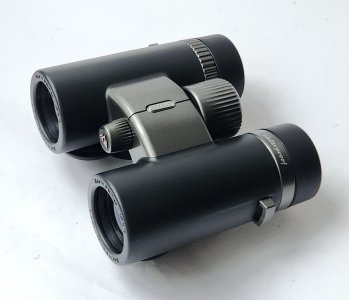
Reasur Nature Traveller 8x32 bino
First impression: it is physically small, like SV202. First impression on viewing: it is bright! Definitely much brighter than Leaysoo. It is less bright than SV202 (very obvious) and Forester HD 2.0 (less obvious). I feel it is brighter than Outland X, but I don't have it anymore to compare.
I'm surprised it is so bright. I checked it does not have phase correction coating (has line across prism when viewed through objective lens), so likely no dielectric reflective coating as well. This probably means all glasses are coated including the prism.
I can merge image easily. Center is not as sharp as SV202, as expected. Field of view is slightly less, so 7.1° seems accurate. Focusing knob has little resistance and is smooth. It is internal focusing, so its claim of being waterproof is likely to be true. Leaysoo claims to be water resistant too, but it is unlikely as it is not internal focusing. It has also little veiling flare.
Minimum focusing distance is 4.6 m instead of 3 m. To be fair, Leaysoo claims 1.3 m, but is actually 3.0 m.
The eyepiece lens is only 18 mm, but it does not seem to have any negative effect.
Case closed!
Macross DYRL 2025

I've not watched it, but from reviews I read online, this is not 'Perfect Edition'.
First, it is cleaned up using AI and some details are removed together with the grain. Colors are also oversaturated.
Second, some sections were filmed out-of-focus. There is no way to correct them.
I have bought DYRL enough times. If they can restore the out-of-focus sections, I'll consider buying it one more time. :lol:
Foldable without compromising sound
After watching several Douyin and Bilibili videos, it is clear that Terence (特伦斯) V50 has the best sound among low-end foldables — it sounds like a piano!
(You can't help but think Terence sponsors many of the influencers. When I search for foldable piano (折叠钢琴), Terence foldables show up overwhelmingly.)
Other than accurate sound samples, this is also due to its dual 15W speakers. You need decent power to produce good sound.
Of course, it is also the most expensive among those compared. Nonetheless, it sets a baseline. Once you hear this, it is difficult to go back.
The speakers face up, this gives clearer sound to the player.
Good speakers are important when you use VST (Virtual Studio Technology). The keyboard acts as a MIDI controller, sends the keypress to a tablet, which then plays much more accurate sound through the speakers via bluetooth — provided the speakers are able to reproduce them.
Or you just want to use it as a bluetooth speaker.
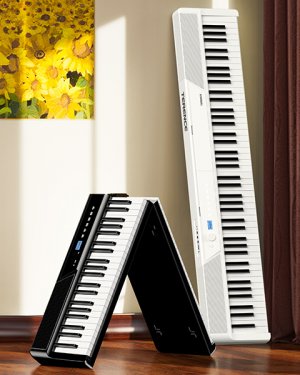
Terence V50
It has non-progressive semi-weighted keys and weighs 5.2 kg. Interestingly, maximum polyphony is not stated. Unfortunately, it does not use USB-C power, so need to bring a separate power adapter along.
Its price is 1,673 yuan (S$311.50) with one-foot pedal. This is even more expensive than Betsy B353! So, buy this only for portability.
For purists, Terence just released V70 that is the world's first foldable hammer-action keyboard. It weighs around 9 kg. It has four speakers: two 20W full-range speakers and two 5W tweeters. The speakers face back, which is better for giving a performance.
CCA: a mini-DSA
SJI has 4 categories of CCAs: Sports, Performing Arts, Uniformed Groups and Clubs & Societies.
There are only a handful of Clubs & Societies and none of them can be core CCA, so effectively there are only 3 categories.
Sports is purely competitive and most have 3-day/week schedule. There is no recreational team.
My son's initial choices:
- PA: Guitar, Band (thrice a week), Drama
- UG: St John, NCC Land, Scouts
- Sports: Canoeing, Tennis, Table-tennis
There is basically zero chance of getting into Tennis and Table-tennis.
Canoeing is tough: thrice a week, external venue, outdoors. I told him no one — except for enthusiasts and DSA — would choose it. He then said he was shortlisted just by attending the trial! I told him this was all the more reason he should not put it as a choice!
I'm also not in favour of Band. It is thrice a week and you need to play in a group. Of the PAs, I only favour Guitar. It is twice a week, but you learn a lifelong skill.
Of the UGs, I feel St John is the most chill. Let's see if it is actually true. I prefer Scouts over NCC, even though need to go an extra Saturday per month. NCC is like serving 4 years of NS. People normally want to serve less, not more. But my son did not want to change the order.
SJI does not have Chess Club, but there is a chess group. I told him to take it into account. He should consider a non-time consuimg core CCA so that he has time for chess. Sometimes, the correct choice is a choice not given to you (directly).
So he modified his choices:
- PA: Guitar, Drama, Band (thrice a week)
- UG: St John, NCC Land, Scouts
- Sports: Tennis, Table-tennis, Canoeing
The selection is out. He got into St John.
I was told UGs are now considered 'dumping ground'. I can see why. Sports is purely competitive. Performing Arts limit their intake. Where can the rest go?
MOE says to take CCA into consideration when choosing secondary school. This omits a crucial fineprint: make sure they can get into the CCA! Often, this means they already have exposure to it. You want to join a CCA to learn from scratch? Nope.
First impressions of Octavebaby 889
This is an OEM model. Its OEM name is Octavebaby (八度宝贝) 889.
It can emulate 200 instruments (音色), has 200 rhythms (音奏) and 80 demo songs (示范曲). So many instruments on a low-end piano means they are not digital samples but are generated synthetically.
The demo songs are all classical music. I only recognize a few of them. The keys will light up as the song plays. What is amusing is that there are frequent tones outside of the 61-keys, so no keys can be lighted up.
The keyboard has touch sensitivity (力度). It has 4 levels of sensitivity — the most I can tell apart, anyway. It defaults to off on power on.
Its specs does not mention polyphony (复音数), speaker power nor weight.
Its measured weight is 1.7 kg.
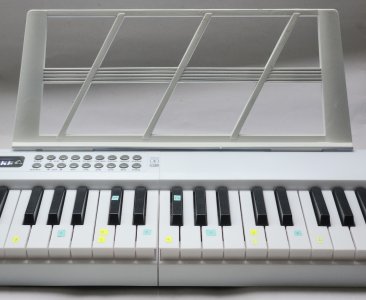
Octavebaby 889
The music sheet holder was black. I sprayed paint it to white.
The speaker quality is pretty bad, as expected. It is missing both low end and high end. This is clear when you use it as a bluetooth speaker. It sounds even worse than my notebook speakers!
The sound is good enough for practice, but you definitely don't want to give a performance with it. Sound through headphone is decent.
The keyboard will cut off previous sounds when I press 4 keys simultaneously twice in quick succession. Pressing 3-3-2 also works. Does this mean it has only 8-note polyphony? :horror:
Is light-up function useful? Not at all, but it looks cool. However, the lighting effect is very bad cos it only illuminates the part of the key where the LED is. If the entire key is illuminated evenly, it'll look super cool.
I don't want to use it to learn. I just want it to show the keys I pressed.
It should use RGB LEDs so that we can change the color. :lol:
Digital pianos
If you want a digital piano, you want weighted keys (重锤). And you probably want progressive hammer action keys (渐进式) as well.
A digital piano's primary purpose is to emulate an acoustic piano. A keyboard can simulate other instruments and is generally designed to be portable and has built-in battery.
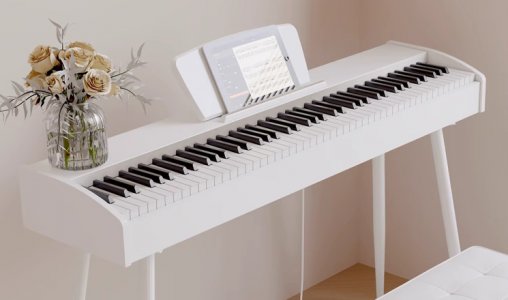
This is the flagship model in its line, but going by price, it is the most entry-level weighted-keys digital piano. It does not have progressive hammer action keys. Maxmium polyphony is either 32 or not stated.
It costs 633 yuan (S$118) [with 3-foot pedal], add 20 yuan for "gift pack", 130 yuan for 4 metal legs and 60 yuan for carrying bag. It is not really portable though — length is 129.5 cm and weight is around 15 kg.
This is almost good enough for me, except for its puny dual 6W speakers. Bigger speakers are louder, but more importantly, the sounds should be more accurate, especially the low-ends.
6W speaker is kind of weak. If only there is one with 15 - 20W.
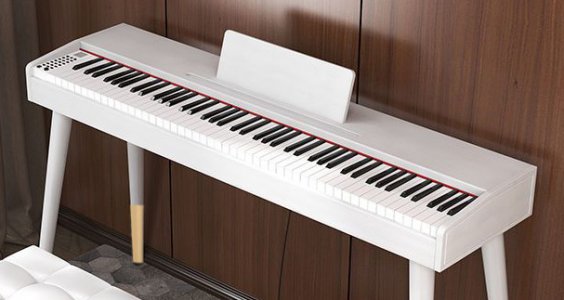
This model has two 10W speakers. It costs 849 yuan (S$159) with 3-foot pedal and metal legs. Single-foot pedal is cheaper by 30 yuan. It has progressive hammer action keys. Maxmium polyphony is not stated.
I don't like the control panel to be beside the keys, though.
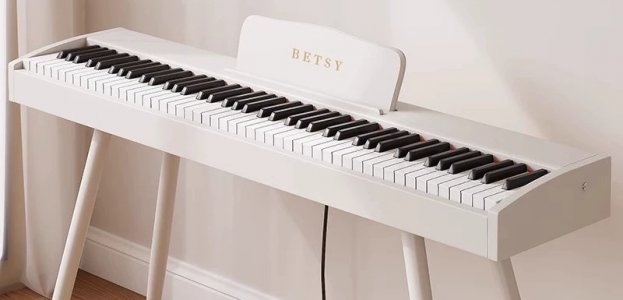
Betsy B353
Apparently Betsy (贝琪) is a famous HK brand? B353 comes with two 10W speakers (*) and weighs around 15 kg. It has progressive hammer action keys and has 128-note polyphony (复音数).
(*) Not sure if it is 2x 10W or 2x 20W. I believe it is the former.
Hardware-wise, it has everything I wanted. Comes with single pedal only. Price is 1,199 yuan (S$224.50) after 600 yuan shop discount, not sure how long or often it is available.
The first two are OEM models, they are available from several low-end brands. Betsy B353 is likely to be an OEM model as well. Its dimensions are 126 x 30 x 10.5 cm — one of the smallest around.
From what I see, the low-end models are "customized" from a template:
- Casing: slab-only, flip table cover, drawer, wooden frame
- Keys: unweighted, semi-weighted, weighted, progressive weighted (*)
- Control panel: yes, no
- Music samples: OEM or custom (this is the secret sauce)
- Polyphony: 32, 64, 128
- Speakers: 6W, 10W
- Speaker orientation: up, back, down
- Common casing color: black, white, wooden, pink
- Common black key color: black, pink, purple
(*) Typically only 3 zones on low-end models.
I prefer slab-based pianos as they take up less space and are easier to move around. A serious pianoist will choose cabinet-style pianos. They have way better sound.
Next step in music
Dreaming about flying even before I start crawling.

Bora BX-20
One level up is the foldable full-size 88-keys Bora (博锐) BX-20. It has touch-sensitive keys, bluetooth and light-up keys. It is 4.0 kg and has two 2W speakers. The flagship model costs 608 yuan (S$114), which is around 50% higher than similar models from other brands.
BX-20 is already trashed for its lousy speakers. I can't imagine what it is like for other brands.

Bora BX15S
I found that Bora has BX15S, which is a foldable semi-weighted 88-key keyboard. It has bluetooth but no light-up keys. It weighs 5.5 kg and has two 25W speakers! It is available in black only. It seems to be for wholesale only, so must find it under other brands. I've not seen it on TaoBao so far.
(It is available on Alibaba for US$106 (776 yuan) plus US$56 shipping to Singapore. It may also be available in white.)
I don't need 25W speakers, but 15 - 20W would be nice.
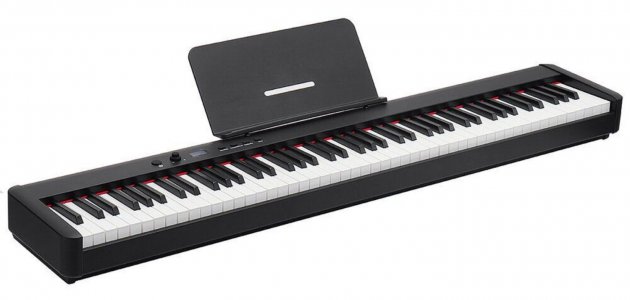
Bora BX5
Bora BX5 is the keyboard to beat. It has weighted keys, weighs 14 kg and has two 25W speakers. It costs 1,471 yuan (S$275.30), comes with bag. It is not foldable, though.
Unfortunately, it is only available in black and does not have 4-leg stand option.
On Alibaba, there is a vendor selling a single unit for US$143 (1,047 yuan) plus US$72 shipping to Singapore even though its MOQ is 8 units. It lists white as an option!
J6 miscarriage of justice
One president pre-emptively pardons the J6 committee.
Another president pardons the J6 "rioters".
They can't be both right, right?
It's funny that Demoncrats justify pre-emptive pardon to prevent lawfare — the very tool they use on their opponents.
So they know its power and damage.
Trump is one of the few people who can survive lawfare. You need to be clean (enough) and be able to afford it.
Imagine digging through 40 years of a person's life and all you can bring up are fabricated charges?
Many people have a bad impression of Trump. He is rich. He must be a playboy. He must lead a decadent lifestyle. He cares only about himself.
I'm not saying he is goody two-shoes. One must be ruthless to some extent to survive in the business world.
Getting started with music

A 61-key foldable digital keyboard with touch-sensitive keys, bluetooth and light-up keys. All for 199 yuan (S$37.30). Pay another 30 yuan to get a pair of earphones, keyboard cover, single-foot pedal and a bag.
The base model (non-touch-sensitive keys, no bluetooth and no light-up keys) is a mere 119 yuan (S$22.30). The bluetooth model (no light-up keys) is 169 yuan (S$31.60).
The keys are only 20 mm wide. Only 88-key keyboards offer 22 mm keys.
The weight is not stated, but based on a similar model from another maker, it should be around 2.0 kg.
The speaker power is also not stated. Based on similar products, it should be dual 2W speakers.
At this price, you can't expect too much quality. The key selling points are portability and light-up keys.
Super wide binos
I was able to find super wide binos all of a sudden.
| SAGA (萨伽) 飞鹰 | BOSMA (博冠) 蜂虎 II | BOSMA (博冠) X | BOSMA (博冠) 青龙 | |
|---|---|---|---|---|
| Power | 8x42 ED | 8x42 ED | 8x32 ED | 8x42 ED APO |
| Prism | BAK4 | BAK4 | BAK4 | BAK4-HT |
| L FoV @ 1000 yards | 423 ft | 426 ft | 435 ft | 477 ft |
| Angular FoV | 8.1° | 8.1° | 8.3° | 9.1° |
| Flat field | N | Y | Y | Y |
| Light transmission | ? | 89% | 90% | 92% |
| Min focus | 1.5 m | 2.5 m | 2 m | 2 m |
| Eye relief | 13.0 mm | 17 mm | 17 mm | 18 mm |
| Eyepiece lens | 24 mm | 24 mm | 23 mm | 27 mm |
| Weight | 700 g | 740 g | 540 g | 925 g |
| Price | 811 yuan | 722 yuan | 1,349 yuan | 2,499 yuan |
These binos all have FMC, phase correction coating and dielectric reflective coating.
I did not know APO was a thing for binoculars. Nor had I heard of BAK4-HT.
Light transmission is rarely mentioned. It seems the practical max for a roof bino is 93%. 89% is pretty good. If not mentioned, fully multi-coated (including prism) should be around 85%. Fully single-coated is said to be 75%.
SAGA has 3 lines of binos: 猎鹰 (low-end), 飞鹰 and 猎峰. 飞鹰 has normal and ED variants. 飞鹰 8x42 is 449 yuan, 8x42 ED is 811 yuan. Some shops say the 449 yuan model has ED glass, but the official website (sagaoptics.com.cn) states otherwise.
BOSMA X is the only shortlisted 8x32 bino. There are few 8x32 binos with FOV more than 8°.
BOSMA 青龙 has the best spec I've seen so far, but its price is also incredible — and it is heavy too. There is no free lunch.
Another 8x32 bino contender
When the Forrester bino was on its way to me, I continued to look up more 8x32 binos.
To my surprise, I saw a couple of reviewers singing the praises of the US$100 Svbony SV202 bino. They were surprised it punched above its weight — it was comparable to binos 3x its price.
It has everything the Forrester Gen II HD has, plus ED lens — unheard of in this price range.
One seller — the same seller I bought the Leaysoo bino from — had it at 555 yuan (US$76). I hesitated for a while — do I really need another bino — but I still bought it. Unfortunately, he told me to cancel my order as it was out-of-stock.
I found another seller listing it at 574 yuan (S$106.60). Other sellers list it at 730+ yuan, matching its MSRP, so it could be a pricing anomaly or there was a price increase and this seller did not get the memo.
The seller told me it was out-of-stock, it would take a week for stock to arrive. No problem, I can wait.

Svbony SV202 8x32 bino
| SV202 | Forester HD 2.0 | Leaysoo | Outland X | |
|---|---|---|---|---|
| Power | 8x32 ED | 8x32 | 8x32 | 8x42 |
| Prism | BaK-4 | ? | BAK4 | BaK-4 |
| Prism coating | di-electric, phase correction | di-electric, phase correction | ? | ? |
| Coating | SMC | FMC | FMC | MC |
| L FoV @ 1000 yards | 409 ft | 387 ft | 357 ft | |
| Angular FoV | 7.79° | 7.37° | 6.8° | |
| Min focus | 2 m | 1.2 m | 1.3 m | 4.0 m |
| Eye relief | 15.6 mm | 17 mm | 16.5 mm | 17.8 mm |
| Eyepiece lens | 21 mm | 21 mm | 19 mm | 21 mm |
| Weight | 477 g | 555 g | 470 g | 624 g |
| Weight (measured) | 510 g | 570 g | 410 g | 550 g |
Interestingly, it is smaller and lighter than the Forrester Gen II HD bino.
Comparing it against Forrester:
- Sharper in center, easier to focus
- Slightly brighter, can see more clearly in low-light
- FoV is marginally bigger only
- No less color fringing! Shouldn't ED lens eliminate it?
I googled "sv202 color fringing" and found someone's feedback:
- FoV is 0.2° narrower than spec — no wonder
- Off-axis CA (Chromatic Abberation)
- Strong pincushion distortion
It looks like the ED lens is not really working. A true ED lens will eliminate color fringing. Well, you get what you paid for.
Svbony SV202 bino is also available as Shuntu's (胜途) 小钢炮 series.
And now that I know better, I'm going to look for:
- ED lens
- Angular FoV 8.1°
- Flat field
I'm not planning to get one any time soon, though.
The perfect wildfire
From Elon Musk:
Strong wind. Dry weather. Uncleared vegetation. No water.
Two of them are man-made.
The cause is not important — wildfires happen all the time. What is important is why the fire failed to be contained.
Hawker food must be cheap, period
News: Singaporeans’ reluctance to pay more for hawker food is endangering the trade
Is it reasonable to say that everyday Singaporeans rely on hawker food, hence it ought to be cheap amid high costs of living?
In recent years, the financial sustainability of Singapore’s hawker trade has become a pressing concern. Hawkers face numerous challenges, chief among them being rising costs of manpower and raw materials.
Some hawkers report operating costs exceeding S$10,000 per month. Yet, the public’s expectation for affordable food options forces them to operate with extremely thin profit margins, sometimes as low as 20 to 30 cents per bowl.
The ramifications of this financial strain are profound and manifold. For one, it deters younger generations from entering the trade. Some established hawkers, like Melvin Soh of the 17-year-old hawker business Toast Hut, have closed their stalls due to staffing issues, according to news reports.
In the case of Toa Payoh zi char stall Hong Sheng Restaurant, which recently ceased operations after 50 years, older hawkers actively discourage their children from taking over. These are not isolated incidents but symptoms of a systemic problem.
However, implementing higher pricing is challenging for many hawkers. When hawker Douglas Ng raised his fishball noodle prices by 50 cents, his business dropped by 40 to 50 per cent.
How can we understand Singaporeans’ reluctance to pay for hawker food and the complex landscape of hawker food pricing?
EXPECTATIONS OF LOW PRICES
According to former head chef Nurl Asyraffie Mohamed Shukor, who now runs hawker stall Kerabu by Arang, patrons at hawker centres expect fast, cheap and filling meals.
In an 8days interview, he explains: “A lot of people don’t understand my food and they ask, ‘why is it so expensive?’ They don’t understand the work behind it. For the chicken, I need to brine it for two hours, then marinate overnight. The whole process is very tedious but they only see rice, chicken, and salted egg on the plate and think it should be S$3.”
However, this seems not to be the case for BlackGoat, a popular hawker stall serving Western-style cuisine, with prices ranging from S$9 for a brownie to S$59.50 for 495g of striploin, significantly higher than traditional local hawker fare. According to BlackGoat’s reviews, customers deem the food “value for money”.
It appears that hawker patrons expect local fare to remain cheap, but are willing to spend more money on other cuisines. Is it a case of double standards?
While Singaporeans’ reluctance to pay more for hawker food could be attributed to internalised bias - where Singaporean cuisine must justify its worth, while foreign cuisines, such as Italian or Japanese, are priced without question - the issue is more complex.
Singaporeans perceive traditional hawker food as “everyday food” rather than an occasional luxury. While fishball noodles may require more work and incur higher production costs than aglio olio, for instance, one could argue that it is the frequent consumption, rather than its lack of inherent value, that drives consumers to demand lower prices.
After all, there are successful entrepreneurs who sell local dishes at premium prices outside traditional hawker centres.
For example, the air-conditioned restaurant The Coconut Club offers their signature ayam goreng berempah nasi lemak at S$22.80, while a bowl of prawn noodle at Zhup Zhup, an open-air restaurant, ranges from S$14 to S$20.
During a recent visit to Zhup Zhup well before dinnertime, I was surprised to see most tables occupied with customers. However, for most hawkers serving traditional fare at hawker centres, the notion that prices should be kept low persists.
SHOULD HAWKER FOOD BE “EVERYDAY FOOD”?
Hawker centres provide accessible and affordable food options to all Singaporeans, rich and poor. In a 2018 National Environment Agency survey, 83 per cent of respondents said they eat hawker food at least once a week.
Hawkers are in an unenviable position as not only the providers of daily sustenance for Singaporeans, but also protectors of a UNESCO-recognised intangible cultural heritage. With chronic diseases such as diabetes and heart disease on the rise, there is an additional responsibility for hawkers to serve healthy options.
Is it reasonable to thrust these burdens on hawkers? Should hawker food still be considered everyday food, and hence kept cheap amid the high cost of living in Singapore?
In discussions on hawker food pricing, one cannot neglect the elephant in the room: Rent. In response to my commentary on the necessity for hawkers to raise their prices, some netizens suggested that increased hawker prices and consumers’ willingness to pay would only encourage landlords to further increase rental fees, leading to a cycle that does not benefit hawkers.
However, contrary to popular assertions of high hawker rents, data from the National Environment Agency (NEA) indicates that the median assessed market rent for non-subsidised market and cooked food stalls has remained at approximately S$320 and S$1,200 per month respectively since 2019, and only about 4 per cent of cooked food stalls in hawker centres are paying rent above the assessed market rate.
Proponents of keeping hawker prices low also argue that raised hawker food prices would disproportionately affect lower-income households. However, here’s the irony: The typical earnings of hawkers themselves fall within the second lowest income decile.
AN UNEXPECTED SOLUTION
Having lived in Australia and currently residing in the Netherlands, I’ve observed that it’s common for locals to leave work punctually at 5pm or 6pm, allowing ample time to shop for groceries and cook at home. While affordable food options exist in these countries, they are not comparable to Singapore’s hawker food, which is accessible and fully integrated around workplaces and in housing estates.
In countries where eating out is expensive and people are compelled to cook, a shift in working culture is demanded. However, in Singapore, the situation is reversed: Hawker food greatly conveniences and subsidises the lives of Singaporeans.
To safeguard our hawker food culture, one of the solutions might be hiding in plain sight. We will need a healthier working culture - one that encourages Singaporeans to cook more at home, like that in other developed countries. While it may seem counter-intuitive, I believe that this cultural change would not only alleviate the pressure on hawkers to provide low-cost meals, but also potentially go a long way in preserving the trade for the future.
The debate about hawker food prices elicits complicated emotions in me. As someone who grew up on S$3 chicken rice and 50-cent char siu bao, the abundance of affordable yet superlatively good hawker food has always been a point of pride when speaking about my homeland or hosting international guests.
The confluence of good food and low prices in a developed country is so uniquely Singaporean. Yet as the hawker situation grows increasingly dire, I catch myself when I laud this.
Because when we talk about the affordability of hawker food as one of its key defining traits, or when we relish being a First World country where superb meals can be had at Third World prices, what are we celebrating?
Hawker food, like public transport, are at the bottom of the "food" chain. They have direct impact on the cost of living.
That's why their prices should be kept low. Increase them, cost of living goes up, the effect cascades across the entire "food" chain, causing another round of price pressure.
Being a hawker is hard work. It comes with the job description. But to say hard work allows food to command high price? No.
Is rent really as low as stated? NEA always says it is low (citing median rent across all hawker centres), but anecdotal accounts always suggest otherwise — especially for non-NEA managed places.
And then there are "upscaled" hawker food. These should really be cafes, but of course they can't afford to rent a place. They can exist, but they should be minority — no more than 20%.
A mid-end 8x32 bino
After I got the Leaysoo bino, I spent some time researching the difference between cheap and expensive binoculars.
Shouldn't I have done it before buying? It didn't matter, because Leaysoo was supposed to replace TRU. The main criteria was price.
Now, I'm interested to replace my Outland X 8x42 bino. It is time to get serious.
Three good-to-have:
- All air-to-glass surfaces should be coated, including those on the prism
- Prism should have phase correction coating
- Prism should have dielectric reflective coating
The third one is optional, but the first two are almost mandatory. Generally, if a bino has dielectric reflective coating — this is considered a premium feature — it will have the other two as well.
I found a suitable candidate: Forester Gen II binoculars. They have 3 models: standard, HD and ED.
Forester describes their binos in detail. Their binos have 8 lenses in 6 groups (4/3 configuration for objective lens [before prism] and 4/3 for eyepiece lens [after prism]). This is a common configuration for mid-end onwards binos. The presence of a standalone lens before prism means it is internal focusing — all but the cheapest binos use internal focusing.
However, they do not list the prism used. This is unlike almost every other bino maker. They just say they use "high precision prism housing".
Their standard bino (448 yuan [S$84] for 8x32):
- coats 13 air-to-glass surfaces, including 1 front-facing from prism
- prism has silver reflective coating only
Truth in advertising: they call this Multi-Coated (MC).
Their HD bino (588 yuan [S$110] for 8x32):
- all 16 air-to-glass surfaces are multi-coated, including 4 from prism
- prism has dielectric and phase correction coating
They call this Fully Multi-Coated (FMC).

(Red = dielectric reflective coating. Yellow = phase correction coating.)
Their ED bino is the same as their HD bino except the objective lens is ED (Extra-Low Dispersion). It costs 868 yuan (S$163) for 8x32. ED lens is not cheap.

Forester Gen II HD 8x32 bino
I got it for 458 yuan (S$86) during a pricing fluke when a shop allowed two discounts to stack by accident — this happens on TaoBao from time to time. Usually the seller will tell you to cancel the order.
| Forester HD 2.0 | Leaysoo | Outland X | |
|---|---|---|---|
| Power | 8x32 | 8x32 | 8x42 |
| Prism | ? | BAK4 | BaK-4 |
| Prism coating | di-electric, phase correction | ? | ? |
| Coating | FMC | FMC | MC |
| L FoV @ 1000 yards | 387 ft | 339 ft | 357 ft |
| Angular FoV | 7.37° | 6.46° | 6.8° |
| Min focus | 1.2 m | 1.3 m | 4.0 m |
| Eye relief | 17 mm | 16.5 mm | 17.8 mm |
| Eyepiece lens | 21 mm | 19 mm | 21 mm |
| Weight | 555 g | 470 g | 624 g |
| Weight (measured) | 570 g | 410 g | 550 g |
As usual, different sellers list different specs (mainly weight) for the same bino.
Forester Gen II 8x32 binos are pretty good specs-wise except for angular FoV. 7.4° is decent, but there are some 8x32 binos that can achieve 7.8°.
Comparing the Leaysoo bino against the Forrester, I find that both have identical FOV. This is the only thing the Leaysoo bino has going for it. It is dimmer and has much inferior optical quality.
Despite its 32 mm aperture, it is brighter than Outland X 8x42 bino. It is not obvious during day time, but is during low-light, e.g. dawn/dusk. Coating beats raw aperture.
Acrylic Carcassonne tiles

I stumbled upon these on TaoBao. 79 yuan (S$15) for 72 basic tiles.
These are made from acrylic and is supposed to achieve a glassy effect — the artwork is under a sheet of glass. Unfortunately, they are not as nice as I thought. If the tiles were 3mm thick instead of 2mm, the glass effect would work better.
I got Rivers expansion (12 tiles) as well. Should have bought Inns and Cathedrals expansion (18 tiles) for 20 yuan as well for completion sake. These are all I need for Carcassonne.
It had not dawned to me that the tiles can be replaced totally. I mean, they are 95% of the game!
There is even a 3D printed set... am thinking whether to get it. It will be the ultimate pimped set. But it will take up a lot of space and won't play as well. It is just a visual treat.
The big spring cleaning
I plan to throw a lot of stuff away, even stuff that are usable — if I haven't been using them and won't be using them in the future.
I still have old receipts and bank/CC statements from 20 years ago. Why do I still keep them?
Also things that are "semi-memorable". If it is not truly memorable, out it goes.
I'm planning to sell these:
- Acquire boardgame 1998 (German ed)
- Celestron Outland X 8x42 bino
- IT-01 Emperor of Destruction (MP-36 KO, Megatron) [considering]
- THF-04 The Hyper Magnum (MP-22 KO, Ultra Magnus)
- XTB MX-30 Fuzz (Streetwise)
- Up to 1/3 of my Archie comics
Need to decide what to do with my DVDs and old computer books. Should I just throw them away?
Back to school

Graduated from primary school. Now have to leave home by 6:15 am.

From now on, 2nd Ji will go to school and come back on his own.
Unlike his brother, 2nd Ji can be very fast. From waking up to out-the-door in 10 minutes. The school is just nearby. He can board the bus at 7:05 am and still be on time.